PDF files has not been created for this issue.
Calligraphy: A traditional form of art and its incorporation into contemporary India
Abstract
The Purpose of this paper is to focus on Calligraphy and its incorporation into contemporary India. Calligraphy is the art of beautiful handwriting with the use of pen, brush, and other tools. The journey of calligraphy in India from ancient times to contemporary has passed through various cultures, empires, and different phases of art movements. Calligraphy has traveled from the handwritten to digital format on various platforms for different purposes. India is known for its diverse scripts and languages. There are diverse languages and cultures in every State of India. India has 22 official languages. India presents endless varieties of physical features and cultural patterns. The walls of Indian villages and cities hold many multilingual calligraphic works of art. These graffiti hold the essence of India. Diversity in the country and among its culture allows the local traditional artists and designers to explore endlessly. Various examples of this paper will broadly focus on the artists and the creative groups of people who not only explore calligraphy as a style of writing but also seek its application as art to present the culture and traditions. Designers use calligraphy in movie posters, brand identity, and various other Media of communication. In the era of information and technology, calligraphy is possible with the various software and applications which give a new life to it. Digitalization of calligraphy assures that calligraphy will not die out/ fall out of this technology and computer-oriented society unlike many traditions of India which have been almost ruled out due to technology. In the current scenario calligraphy is not just a medium of communication, now calligraphy is the part of contemporary art, design, and culture.
Key Words: Calligraphy, Design, Communication, Media, Digitalization
Introduction
India is the land of the god and goddesses. India has a rich cultural and traditional background to its legacy. It is a country of myths and beliefs. The rich diverse culture was developed because India was ruled by many kings, and emperors with different religions and beliefs at different times. The glory of which we can see through the pictures, places, sculptures, and through the documents which are written by hand or carved. Calligraphy is the art of beautiful handwriting. The art of beautiful handwriting is being used by a common man, traditional artists, and designers to communicate the messages or to present art from a very early age. Calligraphy, in this era of technology is also possible with the various software and applications that are blooming. A calligraphy artist plays with the beauty of the characters. He cuts, overlaps, and plays with different sizes and composition styles. In a country like India with great history and heritage, calligraphy is found at a variety of places like Ashok Shilalekh and the urban shopping malls. The hand-painted letterforms now in the era of information have become digitized letterforms. These fonts have their own charm and beauty.
Development of Scripts in India
There are a total of 22 official languages in India. They have come forward from the ancient Indian written languages such as Pali, Sanskrit, and Hindi. In India, the majority of languages are written in Brahmi scripts such as Devanagari, Tamil, Telugu, Kannada, Odia, Eastern Nagari Assamese/Bengali except for Urdu which is written in Arabic script and Santhali uses its own independent script.
Historical Monument
Built by the Mughal rulers of India, the Taj Mahal is one of the Seven Wonders of the World and a very popular historical monument. The Taj Mahal is beautifully decorated in red and green floral motifs, mostly engraved in marble or pietra dura, a technique of stone marquetry. Persian calligrapher Amanat Khan resided at the Mughal court and was responsible for making the calligraphy of the entire Taj Mahal. The text is written in a language close to the 'Thuluth'. His signature can be noticed many times on the marble. Historian Wayne Begley suggested that Amanat Khan not only did the practical design of the script but also did the choice of texts. Most of the texts come from the Koran. Fourteen entire chapters including twenty-two passages some of which are read at Islamic funeral ceremonies. Tombs are also covered with calligraphic inscriptions referring to the Koran.
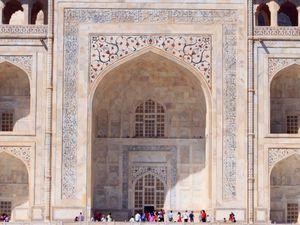
Fig. 1
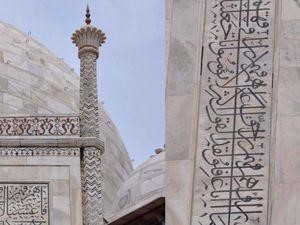
Fig. 2
Calligraphy in Advertising
The role of Advertising is like a mediator between the consumers and the manufacturers. Advertising agencies use different media or communication to present the idea. There are various media of communication like print advertisements, posters, hoardings, and new media of communication. Cadbury Dairy Milk, the flagship brand of Cadbury India has recently launched a new campaign, 'Shubh Aarambh'. Created by Ogilvy & Mather, the campaign is based on the concept of the Indian tradition of having something sweet before every auspicious occasion, with the belief that it leads to a favorable outcome. To highlight the Indian tradition they have used calligraphy to present the concept of ‘'Shubh Aarambh'.

Fig-3
A logo is a design symbolizing one's organization. A logo is a simple visual mark to identify your company product or service. Different types of signs, emblems and typography is used to recognize and associate the logo with a particular product, service, or brand. The archived logos celebrate various self-expressions of Calligraphic masters of the Indian subcontinent. Calligraphy is primarily the visual art of writing. The various styles of the calligraphic hand skill presented in this archive celebrate simplicity, harmony, beauty and manual resonance with which the letterforms sing and dance indifferent rhythms. It re-translates a unique and distinct identification of “Diversity in India'' viewed with the lens of this visual art of writing. Signature is the one of the liquor brands in India. To present the essence of the word, signature has used handwritten calligraphy and converted into the digital format.
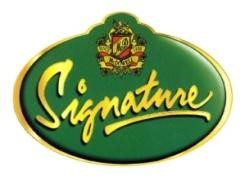
Fig-4
Hand Bag
Launching on Republic day eCoexist will be making a series of cloth bags celebrating Indian languages - we call them our Bhaashaa bags! They started with Devanagari.These bags have been developed along with the NGO Aksharaya based in Mumbai.
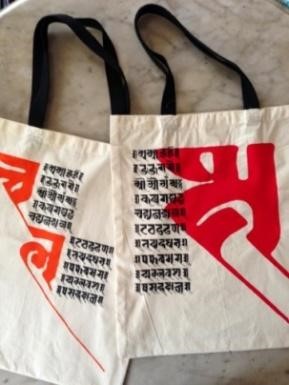
Fig-5
Film Poster
Country like India produces approximately 1000 films every year in over 20 languages. When we talk of national appeal, it is Bollywood, or the Hindi film industry. Bollywood movie posters continued to be designed largely in hand-painted format, up until the 1970s when cut-paste techniques came into being. These techniques were much faster and required little creativity. The use of hand-painted Bollywood posters in film publicity gradually began to take shape in the 1920s. The oldest surviving hand-painted movie poster in Indian cinema is of 1924 Marathi movie, Kalyan Khajina. The alluring art of hand-painted Bollywood posters has traveled a long way since then – from serving as the primary advertising medium in the golden era of Indian cinema to the present day, where it serves as a subject of much curiosity for art lovers, historians, vintage & antique collectors, Bollywood movie poster aficionados, interior decorators, art galleries, museums, and commercial premise owners. The journey of the calligraphy can be seen with the title of the film likes “Dhadak”, “Taare Zamin Par” and in many TV serial titles. They have used calligraphy to express personal thoughts in a traditional way.
 |
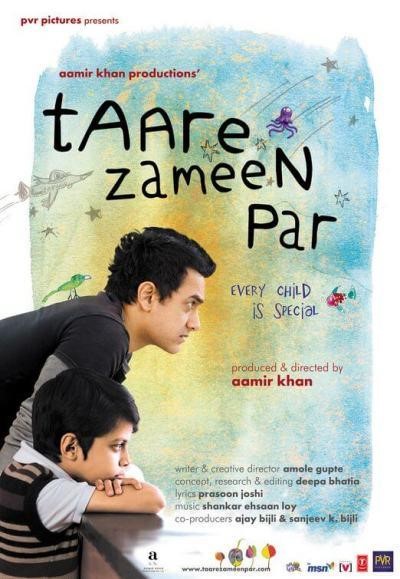 |
|---|---|
| Fig-6 | Fig-7 |
Calligraphy as Art
In India there are a number of typographers and calligraphers who deal with these beautiful fonts and forms as art, playing with its form through various ways of abstraction, distortion, and the placement of the work. Calligraphy is a form of art; related to writing. It is traditionally the design and execution of lettering with a broad tipped instrument or brush in one stroke, as opposed to regular lettering, in which the letters are drawn. A contemporary definition of calligraphic practice is "the art of giving form to signs in an expressive, harmonious and skillful manner". Any language can be written using calligraphy. As an art form, the letters may be written in a simple, functional and legible way or converted into abstract expressions – which may or may not comprise legibility. Calligraphers like Achutaplav, Manohar Desai played with the beauty of letterforms. He dealt with letterforms as a combination of the calligraphy into its simple form of art.
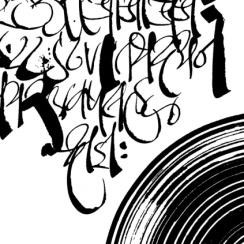
Fig-8
Traditional Artists like painters and street artists who paint the signboards through the letterform likeHanif Kureshi convert the hand-painted types into digital letterforms. In 2010, Hanif took it upon himself to preserve Indian typical calligraphy and ensure it remained a viable trade, at least in some manner. He scoured the brimming labyrinth of Old Delhi for typographic artisans that give life to rainbow letters. For Hanif, this “fate of change” saw the demise of the Bollywood poster painter, and he believes the same end awaits the font makers. “It’s not about saving, the times are changing”.
Conclusion
Calligraphy is the form of written art, which is not only used to communicate the message but which is also a form of Art. In the digital world calligraphy is used by designers to present the essence of Indian tradition. From the historical background, Indian calligraphy exists on the walls of historical monuments and other various media communication. An Indian calligrapher plays with the forms of alphabets. The beauty of the letterforms still exists and will continue to exist in a country like India with different media of communication and a form of art.
Bibliography
- https://www.wonders-of-the-world.net/Taj-Mahal/Scriptures-on-the-Taj-Mahal.php
- https://www.campaignindia.in/article/cadburys-new-thought-shubh-aarambh/412460
- http://wannawritee.blogspot.com/2010/10/morning-moods.html
- http://ecoexistclothbags.blogspot.com/2015/01/bhaashaa-bags.html
- http://bollywoodmovieposters.com/hand-painted-bollywood-posters-history/
- https://www.tfod.in/photos-art-design/calligraphy
- https://www.glyphics.co.uk/hand-painted-typefaces/
Image Source
- https://www.wonders-of-the-world.net/Taj-Mahal/Scriptures-on-the-Taj-Mahal.php
- https://www.wonders-of-the-world.net/Taj-Mahal/Scriptures-on-the-Taj-Mahal.php
- http://wannawritee.blogspot.com/2010/10/morning-moods.html
- http://www.dsource.in/course/calligraphy/examples/achyut-palav/portfolio-1
- http://ecoexistclothbags.blogspot.com/2015/01/bhaashaa-bags.html
- https://www.imdb.com/title/tt7638344/mediaviewer/rm510871040
- https://bestoftheyear.in/movie/taare-zameen-par/
- http://www.dsource.in/course/calligraphy/examples/achyut-palav/portfolio-1